Paludiculture Newsletter 2|2024
General information and news on peatlands and climate
Underestimated and threatened: Peatlands in the Brazilian Cerrado
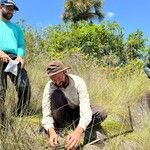
Brazil is huge, but the community of peatland researchers is small. Felix Beer, PhD student at Greifswald University, has recorded the distribution and condition of peatlands in the Cerrado in central Brazil. Here is his field report from an area 7 times the size of Germany.
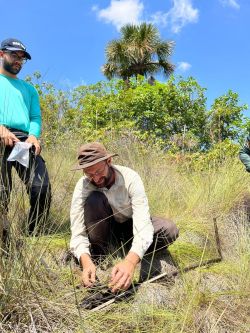
The sun burns from above, the dusty air flickers over gnarled, crowded bushes and trees. The red, sandy soil is only sparsely covered with grasses. You wouldn't really expect to find peatlands in the mostly dry, hot savannah region of Cerrado in central Brazil. But then the landscape suddenly thins out and the earth becomes damp and black. Sedges, grass bulrushes and small shrubs stretch far along a flat valley and are occasionally dotted with Buriti palms (Mauritia flexuosa), which reach up to 20 meters into the blue sky. In the middle of the valley along a stream, the buritis are lined up like a string of pearls. Right at the edge, where our shoes are already sinking in but our feet are not yet wet, we test the thickness of the organic soil with a folding probe and take our first samples to determine the carbon content later in the laboratory. Two hours and three boreholes later, we are standing in the middle of the peatland on 3.5 meters of peat, our legs wet up to our hips and totally sweaty, and we are surprised and happy. Our team, Cássia Munhoz, Professor of Botany at the University of Brasília, two of her students and I, are in the process of systematically mapping peatlands in the Cerrado for the first time ever in order to determine their distribution, peat thickness and stored carbon quantities.
And we actually find peatlands everywhere along the humid valleys in a kind of mosaic with other wetlands and much more frequently than we would have expected. In the Cerrado, these palm savannah formations, which occur on the permanent wetlands along shallow valleys, are called veredas.
The Cerrado is criss-crossed by a dense network of river valleys that drain this huge region, which is seven times the size of Germany, towards neighboring biomes. As a result, the Cerrado plays a very important role in the water cycle of neighboring biomes such as the Amazon region and the Pantanal. And it seems that the peatlands, which occur regularly, especially in the headwater regions of the Cerrado, help to retain and store water in the landscape during the rainy season, which is gradually released into the rivers during the dry season. This guarantees a constant flow of water even during the dry phase, which lasts several months.
Initial figures also indicate that although peatlands cover less than 1% of the Cerrado's surface area, they store over 13% of the Cerrado's total soil carbon in their soil, making them extremely important from a climate protection perspective.
Our studies on the importance of peatlands, veredas and swamp forests on peat, as well as the studies of a few other research groups, are also urgently needed and important because the destruction of nature in the Cerrado is progressing faster than in the much-noticed Amazon region. Agribusiness in particular, for example soybean cultivation, but also timber plantations, are severely disrupting the water cycle in the Cerrado. Falling groundwater levels and drying wetlands are the result. Unfortunately, the extent and scale of the deterioration of the peatlands and other wetlands has hardly been recorded. But wherever we went, we were able to observe the consequences of drying out and, for example, peat fires - ultimately the gradual disappearance of peatlands and wetlands.
In addition to the scientific work on the topic, we believe that an important step is to raise awareness in Brazil of the existence of peatlands in the Cerrado and their importance. The term peatlands (turfeiras in Portuguese) is only known to a small research community, even though the general importance of wetlands is clear.
Stay tuned for the first scientific results from our Cerrado peatland research project!
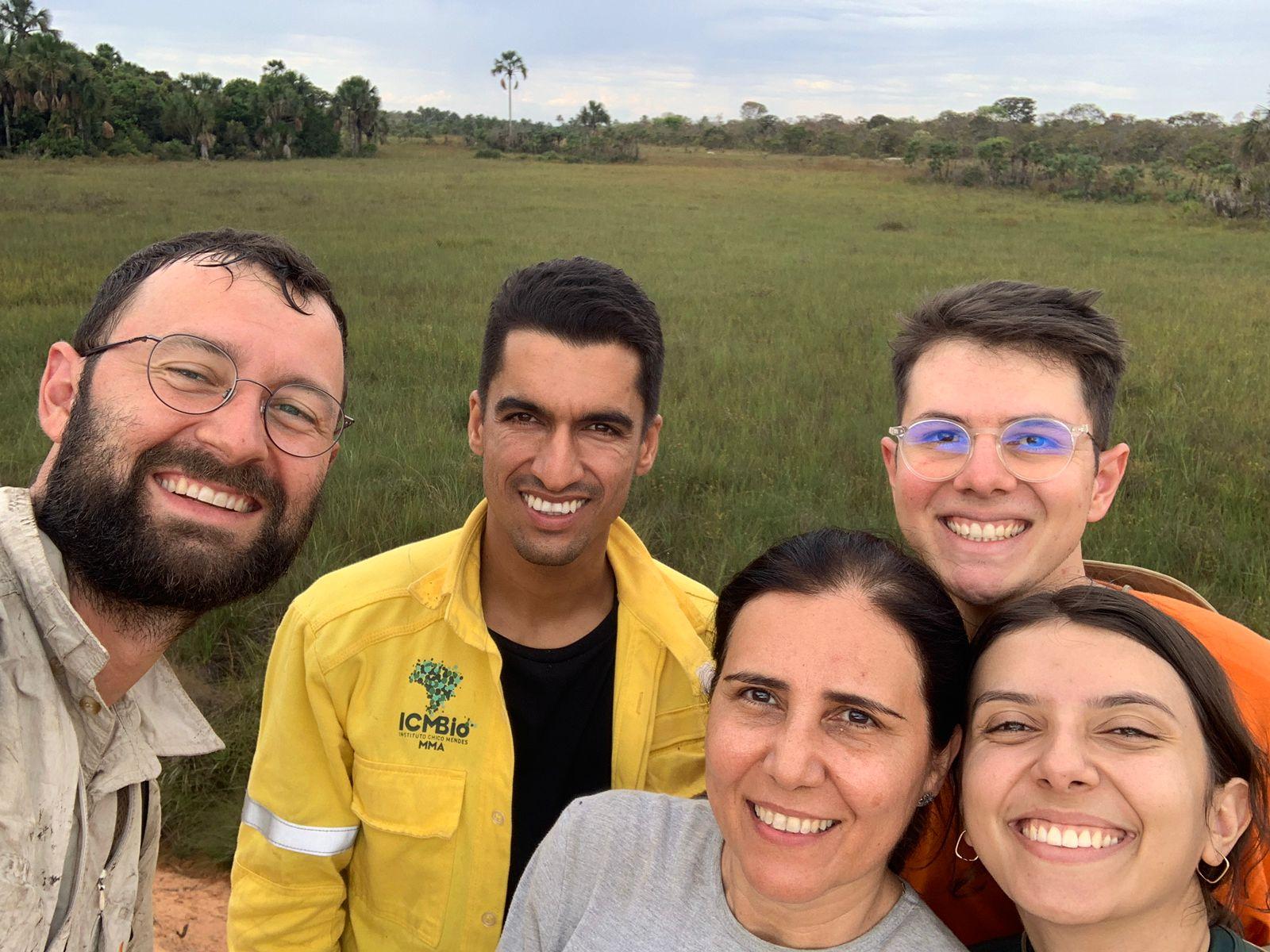
Good-humored researchers in the Brazilian peatlands. Picture: Felix Beer.
Author: Felix Beer, Greifswald Mire Center
Save the Date for RRR2025
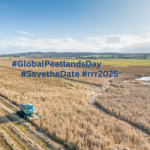
The 4th international RRR conference on "Renewable Resources from Wet and Rewetted Peatlands" will take place in Greifswald from September 23rd to 26th, 2025, and will bring together experts from various disciplines to exchange knowledge and experience and discuss pressing issues in paludiculture.
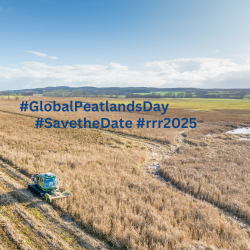
In celebration of this year’s World Peatlands Day, the Greifswald Mire Centre warmly invites you to save the date for the 4th international RRR conference on the Renewable Resources from Wet and Rewetted Peatlands. Taking place in Greifswald, Germany from September 23rd to 26th, 2025, the conference will unite experts from diverse disciplines to share insights and experiences and address pressing questions within the field of paludiculture.
In 2024, "paludiculture" marked its 25th anniversary since being called into life, with significant advancements made in practical knowledge regarding rewetting, cultivation, processing, marketing, policy development and awareness-building, but large-scale implementation is still low. This conference aims to unite stakeholders involved in the utilisation of rewetted peatlands, welcoming scientists, landowners and users, administrators, manufactors, artists, designers and policymakers. By fostering cross-sector networks, sharing experiences and knowledge, we seek to bridge the gap between science and practice and together discuss and shape the future of paludiculture.
Through a diverse program including lectures, poster presentations, excursions, and a range of interactive events, we endeavour to facilitate meaningful dialogue and collaboration. Stay tuned for further details, including abstract submission and registration information, which will soon be available on our website. We look forward to your participation! For conference updates please visit our website rrr2025.com, or follow @greifswaldmoor on the GMC’s social media channels.
First comprehensive climate assessment by the European Environment Agency
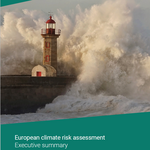
The climate crisis on 400 pages: The European Environment Agency (EEA) has published its first comprehensive assessment of the climate in the EU. It is intended to support decisions on environmental and climate policy in the EU. With 36 identified climate risks, eight of which require immediate action, the report provides a gloomy outlook.
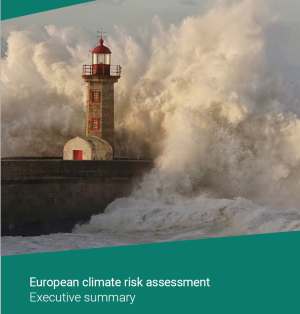
Bad prospects for peatlands in the European Climate Risk Assessment (EUCRA): 50% of Europe's peatlands are degraded and targets for their restoration are mostly not being met, the report estimates, citing scientific publications by the Greifswald Mire Center, among others. Most of the damage is man-made due to land use and drainage. Due to rising temperatures, the permafrost is thawing in many northern European peatlands and evaporation is increasing. Peat mosses are dying, wetlands are drying out and the likelihood of wildfires is increasing.
As a possible ray of hope, the report does not rule out the possibility of peatland areas spreading northwards as the permafrost thaws. Longer growing seasons could improve the vegetation in some peatlands. More plants would then also bind more carbon dioxide.
The EUCRA has identified 36 climate risks for Europe. Eight of these require immediate action and 34 are expected to reach critical and in some cases catastrophic proportions by the end of the century if the status quo continues. Southern Europe in particular is considered a hotspot for several climate risks due to water shortages and heatwaves.
New: Global Wetland Centre in Denmark
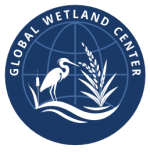
Docked at the University of Copenhagen and supported by the Novo Nordisk Foundation, a new Global Wetland Center will initially contribute to peatland research over the next six years.
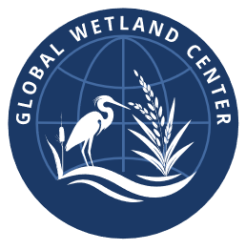
At the Global Wetland Center, officially founded on World Wetland Day on February 2nd 2024, experts from the University of Copenhagen, the Geological Survey of Denmark and Greenland and the Danish Hydraulic Institute (DHI), a software developer for modeling, want to research how peatlands and wetlands can reduce emissions of climate-damaging greenhouse gases. Modeling tools, artificial intelligence and satellite data are being used for this purpose. The knowledge gained is intended to provide countries around the world with concrete solutions for their individual climate challenges and enable political decision-makers to coordinate actions on this basis. Software developer DHI has good contacts in politics. It has been working with the United Nations Environment Program since 1996.
MoorMaidens at the Mapathon
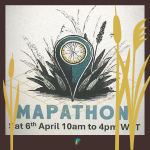
Working together to create a map of Europe's peatlands was the aim of an Open Data Mapathon organized by the University of Galway at the beginning of April 2024. The MoorMaidens from the Greifswald Mire Center were looking for freely available data for mapping peatlands in Germany.
The University of Galway, Ireland, hosted the European Peatlands and Policies Open Data Mapathon at the beginning of April. 20 teams of 184 people were on site or took part in the event online to collect open source data for 14 European countries, such as legal texts and data sets for mapping. Each Mapathon team worked on one country; the MoorMaidens chose Germany. On April 6th, they scoured the web for GIS data and laws at federal, state and municipal level. The result: ten peatland datasets in the form of shapefiles, plus data on land use, water and organic carbon content, as well as ten laws at national and regional level. The final map is currently being created and will be available at the end of June with lots of data from the Mapathon.
Incidentally, Mapathon is not a spelling mistake, but usually a public event - online or in the field - in which volunteers help to improve existing map material with freely accessible data. One original idea, for example, was to map risks for disaster-prone areas. This mapathon, organized by theWaterLands project and the University of Galway, worked with QGIS programme as its main GIS tool. All participants received the work of the other teams afterwards and thus benefited together. The Mapathon was of course also useful as a networking event.
A project presented
MoorPV
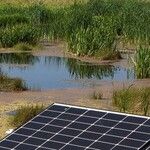
Generating renewable energy and reducing greenhouse gas emissions at the same time - that sounds like a win-win. The new MoorPV project at the University of Greifswald is investigating whether photovoltaics on rewetted peatland areas can benefit both the energy industry and nature without any side effects.
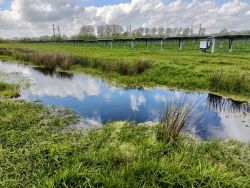
How many greenhouse gases are emitted by a rewetted peatland area with solar modules? How is biodiversity developing there? What about the economic side? The MoorPV project, which was launched at the beginning of 2024, is investigating these questions over a three-year period. The main area under consideration is in Schleswig-Holstein. It is heavily degraded soil that is used for agriculture. First, the water was dammed to a peat-retaining level at ground level and the PV system was installed. Data is collected since March.
Carbon dioxide, methane and nitrous oxide are measured under and next to the photovoltaic modules. It will also be investigated whether the panels minimize evaporation through their shade and thus positively influence high water levels in the peat body. It is also conceivable that shading could have a negative effect on plant growth and CO2 uptake, and how biodiversity develops in the renaturalized area is also part of the project's investigations. Plants, ground beetles, spiders, amphibians, crickets, bats and birds will be taken into account. The economic analyses clarify, among other things, whether the installation of photovoltaics on peatland soil is more expensive than on mineral subsoil and where possible costs could be saved.
Various faculties at the University of Greifswald are involved in the project. It will run until the end of 2026 and is funded by the Joachim Herz Foundation.

Photovoltaics on the test area in Lottorf. Picture: Monika Hohlbein.
News from other paludiculture projects
Rapidly growing demand for paludiculture - now!
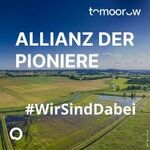
14 well-known companies want to integrate biomass from rewetted peatlands into their production and have joined forces in the PaludiAllianz. The aim is to strengthen the customer side of the paludiculture market and show that wet cultivation can be economical on a large scale.
It was end of April, but the beginning for the Alliance of Pioneers: 14 large commercial enterprises from the paper, packaging, construction, insulation and wood-based material industries declared at a kick-off event in Berlin that they would test renewable, regional raw materials from wet peatlands in their production and integrate them wherever possible. According to the joint press release issued by the Michael Otto Environmental Foundation and the Succow Foundation, partners in the Greifswald Mire Centre, which launched the PaludiAllianz in the toMOORow initiative, the aim is to achieve rapidly growing demand for paludiculture in various sectors of the economy. Well-known companies are now among the founding members: Interest in future paludiculture products in the construction sector has been expressed by prefabricated house manufacturer Bau-Fritz GmbH & Co. KG, the construction group STRABAG SE and OTTO WULFF Bauunternehmung GmbH and Sto SE & Co. KGaA. The companies toom Baumarkt and OBI Group Holding SE & Co. KGaA also consider biomass from paludiculture in the horticulture segment as a supplier of substrates. The retail and service company Otto (GmbH & Co. KG), LEIPA Group GmbH, the WEPA Foundation and, in the area of recyclables management, PreZero Stiftung & Co. KG with OutNature GmbH aim to make paper and packaging more sustainable by adding of paludiculture biomass. Procter & Gamble Service GmbH is involved in the area of consumer goods for household and cosmetics, as is Tengelmann Twenty-One KG with KiK Textilien and Non-Food in the retail sector.
“Development of scalable value chains with paludiculture biomass from rewetted peatlands in Germany in practical cooperation with economic players” (PaludiAllianz) is the detailed title of the project, for which Cem Özdemir, Federal Minister of Agriculture and Nutrition, handed over a funding decision of almost 1.8 million euros over the next three years at Kulturbrauerei in Berlin. As rewetting also offers effective natural climate protection, Federal Environment Minister Steffi Lemke was also a guest speaker at the event.
BLuMo - Water is the key
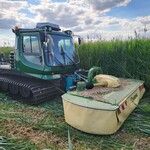
The demonstration area in the BLuMo project in Brandenburg is 750 hectares in size. The Brandenburg State Office for the Environment and the Leibniz Institute for Agricultural Engineering and Bioeconomy are testing paludiculture and want to process the raw materials obtained into useful products.
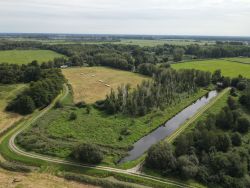
BLuMo stands for "Preserving Brandenburg's peatlands in a climate-friendly way - initiating peatland conservation and management" (BLuMo). The aim of the project, which was launched in 2021, is to raise the water level in peatlands on 750 hectares of demonstration areas in the Rhinluch, Randowbruch and Möllmer Seewiesen and to test paludiculture in the process.
This is not only beneficial in terms of climate protection. Despite its many bodies of water, Brandenburg is one of the driest and lowest-precipitation federal states in Germany. Temperatures are also rising here. More water evaporates and is not available to replenish the groundwater reservoirs. At the same time, climate change favours longer-lasting weather conditions such as periods of rain or drought.
To have a balancing effect on the landscape water balance, the BLuMo project aims to retain and store more water on the demonstration areas and thus prevent the landscape as a whole from drying out during increasingly prolonged periods of heat. In addition, BLuMo is testing the management of wet peatland areas together and in consultation with farmers. The cooperation partner in the BLuMo project, the Leibniz Institute for Agricultural Engineering and Bioeconomy e.V. (ATB), is researching agricultural process chains and innovative solutions for the economic material utilization of peatland biomass as well as the development of sustainable regional value chains. In concrete terms, this means investigations into peat-free potting soils, greening substrates and trials on fiber-based material boards and pellets as bedding material for organic farming. In the Pulp & Paper sector, the ATB is working on the use of biomass in paper and molded parts. This use reduces the ecological footprint through lower water, energy and wood consumption. Products developed to date are at various stages of practical maturity and require further scientific research.
Peatlands, emissions and peatland policy in Brandenburg
Brandenburg has a total of 264,000 hectares of peatland and peatland succession soil, making it the federal state with the third largest area of organic soils after Lower Saxony and Mecklenburg-Western Pomerania. This is just under ten percent of the state's surface area and is roughly the same size as the federals state Saarland. In north-eastern Germany, peatlands are commonly referred to as Luch. There is a great variety of different types of peatland there. Today, only 3% of the peatlands in Brandenburg are still in a near-natural state; most of them have been drained for agricultural purposes, with the result that Brandenburg's peatlands emit more carbon dioxide than the state's entire transport sector.
Politicians have recognized the relevance of peatlands for climate protection and a balanced landscape water regime. The state of Brandenburg adopted a peatland protection program in March 2023. The program takes up the federal state target agreement on climate protection through peatland protection. The aim is to reduce greenhouse gas emissions from peatland soils in Brandenburg by 750,000 tons of CO2 equivalents by 2030. To this end, the federal government is funding a total of nine pilot and demonstration projects in Germany. BLuMo, one of the two projects funded in Brandenburg with a term until the end of 2031, is managed by the Brandenburg State Office for the Environment and funded by the Federal Ministry for the Environment, Nuclear Safety and Consumer Protection.
Author: Bettina Tacke, Brandenburg State Office for the Environment
MoorAgentur MV: Protecting peatlands, promoting paludiculture

The MoorAgentur in Mecklenburg-Vorpommern, which opened on May 2nd 2024, is the first of its kind in Germany. Funded by the German Ministry of Environment and hosted by the Landgesellschaft M-V, the MoorAgentur is intended to support the implementation of rewetting and paludiculture.
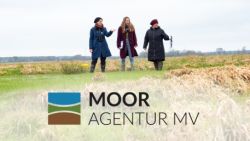
The topic of paludiculture is new and risky for most conventional farmers. Investments seem high, yields uncertain, experience lacking, as do strong value chains for products from paludiculture. Yet it can be an opportunity, both for the environment and for the farmers concerned.
The task of the new MoorAgentur MV is to make it easier for interested farmers to get started. It answers questions about funding, advises on conversion and approval procedures, networks and helps with contacts. The agency sees itself as an interface between practice, administration and science and would like to actively help with the planning and implementation of moorland protection measures.
Events
All current events are compiled in our online calendar.
Literature
Adriani, D., Yazid, M., Riswani, Damayanthy, D., Choi, E., Yang, H. 2024: Livelihood Alternatives in Restored Peatland Areas in South Sumatra Province, Indonesia. Land, 13, 643. DOI: 10.3390/land13050643
Eickenscheidt, T., Bockermann, C., Bodenmüller, D., Großkinsky, T., Gutermuth, S., Hafner, M., Hartmann, H., Hartung, C., Heuwinkel, H., Kapfer, M., Krimmer, J., Krus, M., Kuchler, C., Kuptz, D., Lohr, D., Mack, R., Mäck, U., Mann, S., Meinken, E., Moning, C., Rist, E., Schön, C., Schröder, T., Schumann, A., Theuerkorn, W., Zollfrank, C., & Drösler, M. 2023: MOORuse - Paludikulturen für Niedermoorböden in Bayern - Etablierung, Klimarelevanz & Umwelteffekte, Verwertungsmöglichkeiten und Wirtschaftlichkeit, Abschlussbericht, 254 p. DOI: 10.5281/zenodo.10778063.
Hammerich, J., Schulz, C., Probst, R., Lüdicke, T., & Luthardt, V. 2024: Carbon content and other soil properties of near-surface peats before and after peatland restoration. PeerJ. Apr 18;12. DOI: 10.7717/peerj.17113
Heindorf, C., Schüler, S., & Plieninger, T. 2024: Poetic inquiry to explore the relational values of a transforming peat landscape. People and Nature, 00, 1–17. DOI: 10.1002/pan3.10629
Mander, Ü., Espenberg, M., Melling, L., Kull,, A. 2024: Peatland restoration pathways to mitigate greenhouse gas emissions and retain peat carbon. Biogeochemistry 167, 523–543. DOI: 10.1007/s10533-023-01103-1
Wichmann, S., Nordt, A. 2024: Unlocking the potential of peatlands and paludiculture to achieve Germany’s climate targets: obstacles and major fields of action. Frontiers in Climate 6, 1380625: 1-20. DOI: 10.3389/fclim.2024.1380625








